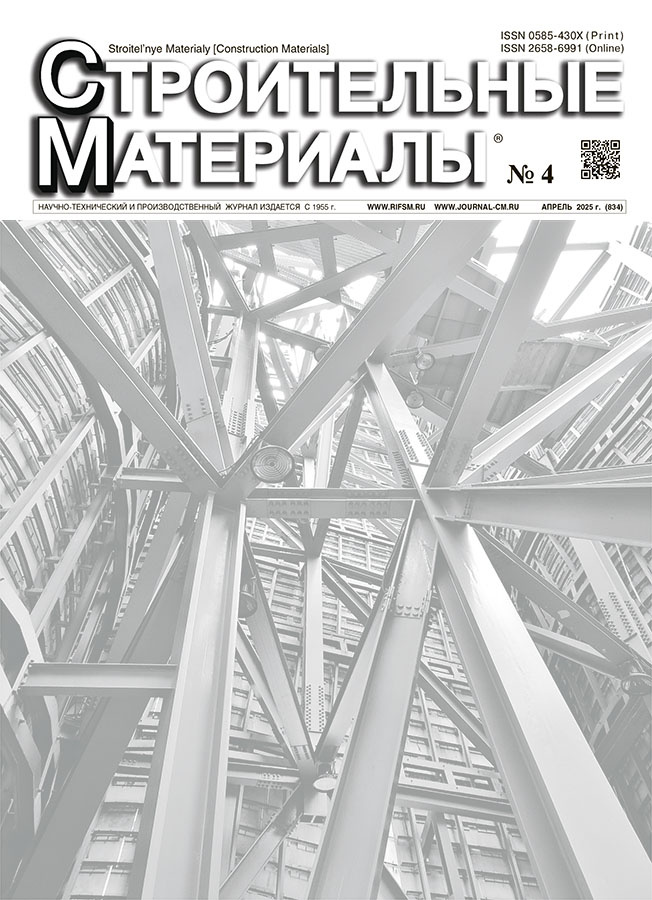Investigation of the effect of chemical activation of masses in the production of ash and slag wall ceramics
- Авторлар: Gur’eva V.A.1, Ilyina A.A.1, Doroshin A.V.1
-
Мекемелер:
- Orenburg State University
- Шығарылым: № 4 (2025)
- Беттер: 40-44
- Бөлім: Статьи
- URL: https://rjonco.com/0585-430X/article/view/682898
- DOI: https://doi.org/10.31659/0585-430X-2025-834-4-40-44
- ID: 682898
Дәйексөз келтіру
Аннотация
Data on changes in the physico-mechanical properties of wall ceramics, depending on the composition of the charge: density, strength, and water absorption, have been obtained. Based on the research results, an optimal composition has been developed using ash and slag waste in a composition with alumosilicate clay raw materials – loams from the Buguruslan deposit. The effect of silica gel on changes in the structure and physico-mechanical properties of wall ceramics of the «loam – ASW» type is presented. It was found that the use of ash and slag waste in the amount of 35% makes it possible to obtain ceramic bricks with a brand strength of at least M150, with the addition of 8 % silica gel. The paper also presents the results of experimental studies to identify optimal drying modes for ceramic raw materials. The most common causes of crack formation during drying are considered, as well as measures to increase the crack resistance of manufactured products using high-quality materials. The effect of the drying time on the firing properties of products with an ash and slag waste content of 35 % by weight, depending on the drying temperature, was revealed. The dependence of the shrinkage value on the moisture level of the ceramic raw material is determined. The developed approaches will make it possible to determine the optimal technological parameters for drying ceramic raw materials based on low-melting loams and ash-containing man-made waste molded by semi-dry pressing.
Негізгі сөздер
Толық мәтін
Авторлар туралы
V. Gur’eva
Orenburg State University
Хат алмасуға жауапты Автор.
Email: victoria-gurieva@rambler.ru
Doctor of Sciences (Engineering)
Ресей, 13, Pr. Pobedy Avenue, Orenburg, 460018A. Ilyina
Orenburg State University
Email: victoria-gurieva@rambler.ru
Graduate Student
Ресей, 13, Pr. Pobedy Avenue, Orenburg, 460018A. Doroshin
Orenburg State University
Email: victoria-gurieva@rambler.ru
Graduate Student, Buzuluk Humanitarian and Technological Institute (branch)
Ресей, 112, Komsomolskaya Street, Buzuluk, 461040Әдебиет тізімі
- Gur’eva V.A., Doroshin A.V. Application of ash-slag ceramics for low-rise construction. Stroitel’nye Materialy [Construction Materials]. 2022. No. 4, pp. 6–10. (In Russian). EDN QMTBDJ. https://doi.org/10.31659/0585-430X-2022-801-4-6-10
- Vereshchagin V.I., Buruchenko A.E., Kashchuk I.V. Possibilities of using secondary raw materials for obtaining building ceramics and glass ceramicsю Stroitel’nye Materialy [Construction Materials]. 2000. No. 7, pp. 20–23. (In Russian). EDN: IAJNNV
- Zakharov A.I., Begak M.V. The program of harmonization of environmental standards as a tool for increasing the efficiency of production of building ceramics. Stroitel’nye Materialy [Construction Materials]. 2009. No. 4, pp. 17–19. (In Russian). EDN: KMKQUV
- Andramonov A.A. Causes of formation and methods of elimination of drying cracks in production of ceramic bricks. Nauchno-Tekhnicheskoye i Ekonomicheskoye Sotrudnichestvo Stran ATR v XXI Veke. 2014. Vol. 1, pp. 116–119. (In Russian). EDN: SGSRCD
- Schlegel I.F. Drying in brick production. Stroitel’nye Materialy [Construction Materials]. 2013. No. 8, pp. 33–36. (In Russian). EDN: RAWVYP
- Usachev A.M., Suslov A.A. Evaluation of crack resistance of raw ceramic products with different drying methods. High technologies in ecology: Proceedings of the 8th International scientific and practical conference. Voronezh. May 18–20, 2005, pp. 142–145. (In Russian). EDN: YXNGOD
- Stolboushkin A.Yu., Stolboushkina O.A., Berdov G.I. Optimization of pressing parameters of granulated technogenic and natural raw materials for the production of ceramic bricks. Stroitel’nye Materialy [Construction Materials]. 2013. No. 3, pp. 76–79. (In Russian). EDN: PXETFD
- Yavruyan H.S., Gaishun E.S., Kotlyar A.V. Features of compression molding of finely dispersed coal enrichment products in the production of ceramic bricks. Stroitel’nye Materialy [Construction Materials]. 2017. No. 12, pp. 14–17. EDN: YMKFAQ
- Kotlyar V.D., Terekhina Yu.V., Almazov S.M., Kotlyar A.V., Yashenko R.A. Clays of the Maloarkhangelskoye deposit are promising raw materials for ceramic materials. Stroitel’nye Materialy [Construction Materials]. 2021. No. 9, pp. 8–13. (In Russian). EDN: LFMLGO. https://doi.org/10.31659/0585-430X-2021-795-9-8-13
- Shmitko E.I., Suslov A.A., Usachev A.M., Afanasyeva S.N. Optimization of drying modes of raw ceramic bricks using the contact-diffusion method. Ogneupory i Tekhnicheskaya Keramika. 2009. No. 7–8, pp. 69–73. (In Russian). EDN: NBIHIH
- Gurieva V.A., Ilyina A.A. Influence of nickel slags on structural changes in ceramic bricks. Glass and Ceramics. 2024. Vol. 81. No. 1–2, pp. 34–38. EDN: AOBHGB. https://doi.org/10.1007/s10717-024-00654-5
Қосымша файлдар












